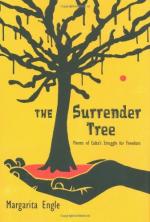|
This section contains 649 words (approx. 2 pages at 400 words per page) |

|
The Surrender Tree: Poems of Cuba's Struggle for Freedom Summary & Study Guide Description
The Surrender Tree: Poems of Cuba's Struggle for Freedom Summary & Study Guide includes comprehensive information and analysis to help you understand the book. This study guide contains the following sections:
This detailed literature summary also contains Topics for Discussion on The Surrender Tree: Poems of Cuba's Struggle for Freedom by Margarita Engle.
"The Surrender Tree: Poems of Cuba's Struggle for Freedom" is a book of poems from the perspective of those involved in the wars for Cuba's independence. It reveals what life was like during the nineteenth century for both Cubans and the Spanish that fought for control of this jungle island.
Part One is mainly from the perspective of Rosa. Rosa is a young girl who many believe to be a witch. In reality she is a medicine woman who has a gift of healing with natural remedies. Throughout most of the chapter, Rosa describes the plight of the runaway slaves. They hide in caves but are often caught and run away again. Rosa also spends this first section of the book observing the slavehunter and his son as they catch slaves and collect the ears of those they have killed. The other character who speaks this section is known as Lieutenant Death, the son of the slavehunter. He learns the tricks of his father, as well as his narrow mindset. His last poem reveals the fear he feels regarding his father's work as a slavehunter. The section ends with Rosa's poem. She tends to both slavehunter and slave, as well as wild dogs and tame ones. Unlike the people, the dogs do not see her as a witch; they trust her. She believes it must be difficult to learn to hate.
In Part Two, Rosa continues with her nursing the ill as Cuba is suddenly free. The slaveowners have rebelled against Spain, freeing the slaves and taking up arms against the Spanish Empire. Rosa can hardly believe this has happened. Although freedom has occurred, it does not last for long. Spain does not accept the freeing of slaves, so now all slaves must go into hiding. Farms, homes, and towns are burned by both the Spanish and the rebels, and Rosa wonders if she should fight with weapons or medicine. She chooses to heal. In this section Rosa falls in love and marries a freed slave named Jose. Together they work as nurses. Many of Jose's poems are about Rosa and her work. While some of Rosa's are about the fear she feels for those around her and their future. Lieutenant Death has grown up and hardened his heart against Rosa and the rebels. He vows to kill her. The chapter ends with a peace treaty in which the Spanish still own Cuba. Rosa wonders if the war was worth it.
Part Three is a short section regarding a war that was considered small, although Rosa questions if any war can be considered small when there are lost lives. She sees war as just another form of slavery. Jose sees all they do as a repetition of what has already taken place. Part Four begins with a description of a famous Cuban poet, Marti, who is killed. It is decided by Weyler, a military leader, to force all peasants into reconcentration camps in only eight days. All other found in the country after eight days would be killed. A new character, Silvia, is introduced in this chapter. She escapes from the camp and joins Rosa in healing others. In the end of this section one of the rebel leaders has been killed, but, on a positive note, Weyler has not succeeded in destroying the rebellion and is sent back to Spain. The camps are now open.
Part Five describes the involvement of the Americans in the Cuba war for independence. In the end, the Americans take over control of Cuba. Although it is not the freedom the Cubans had hoped for, it still gives them a chance to hope for the future. The final section describes the author's connection to the Cuban fight for freedom, the historical facts that are connected to this story, and a chronological list of historical events pertaining to this story.
Read more from the Study Guide
|
This section contains 649 words (approx. 2 pages at 400 words per page) |

|



